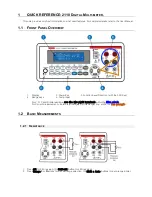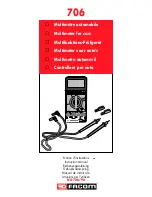
Digital Multimeter
Theory of Operation
17
Analog to Digital Converter
U3 is a 20-bit
Σ∆
analog-to-digital converter (ADC). C21 & C22 are power-supply
bypass capacitors. The DC signal at FE_O (U1 pin 19) provides the signal input for U3.
The reference for conversion is supplied by U8 as described in 1.3 to the REF and VIN*
(compliment of VIN) inputs. Since REF* (compliment of REF) is tied to -2.5 V and both
pairs of inputs to U3 are handled differentially, the dynamic range of the VIN is ±1.25 V
around COMMOM. The microprocessor U2 uses three digital lines to communicate with
U3. U3 signals the microprocessor U2 that a conversion is completed by pulling the SDO
signal line to logic low (-2.5 V), which is coupled through current limiting resistor R31
to DOUT. When U2 is ready for the reading, it pulls ADCS* of U3 to a logic low and
clocks the data serially out of SDO with the signal ADSCK applied to SCK. Connecting
F0 of U3 to -2.5 V sets the internal clock so that the normal mode rejection ratio
(NMRR) of the digital filter will provide adequate rejection of both 50 Hz and 60 Hz.
Secondary Analog Circuits
Several secondary analog circuits are used to provide signals to a 12-bit, 200 kilo
samples per second (ksps) (8000 sps is the highest rate used) analog to digital converter
(ADC) with eight multiplexed-inputs in U2.
R7, R48 C31 & CR5 form a circuit that determines whether a plug is inserted into the
mA/
µ
A input jack. The signal MAJACK is held at -2.5 V via R48 if the split-jack J1 is
not shorted by a plug. When a plug shorts split-jack J1, current will flow through R7 and
the MAJACK signal is pulled to near COMMON via R28 or R4 and/or R5. MAJACK is
measured by U2 to determine if the function selected by the rotary switch S1 is in
conflict with the Meter inputs. C31 suppresses high frequency noise. Diode CR5
provides protection in case F1 is open. R10, R11, C26 & CR6 provide the same function
for the
A
input with the COMMON connection via R6.
R97 & R98 allow the Meter model and possible revision number to be read by the
microprocessor U2 as an analog signal over the single signal path MODEL.
R34, R35, R36, R37, C56 & U4 form a buffer and analog level shifter for allowing the
ADIN signal to be sampled by the faster U2 ADC. This ADC is used for auto-ranging,
for bar graph readings and
p
m
. R34 and R35 set the DC gain at the output of
U4 to 2. Since the dynamic range of ADIN is ±1.25, the signal at the U4 output is ±2.5
V. Since R36 and R37 form a voltage divider referenced to -2.5V, the signal at
FASTADIN has a dynamic range of -2.5V to 0 V with respect to COMMON. C56
provides a band-limited response to the higher frequencies contained in signals that are
being evaluated for
p
m
. C39 bypasses U4 power supplies.
S1, R22, R53, R54, R55, R58, R59, R60, R61, R84 & C20 allow the position of the
rotary switch S1 to be read by the microprocessor U2 as an analog signal over the signal
path SWPOS. U2 reads the position of S1 by pulling the SWPWR signal to logic high
(+0.8V) and reading the signal at SWPOS. The voltage divider formed by R61, R60,
R59, R58, R55, R54, R53 & R84 creates a signature voltage for each switch position of
S1. R22 will pull this voltage down slightly when the divider taps are connected, but will
pull the SWPOS voltage to -2.5 V when S1 is between switch positions. C20 suppresses
noise.
R15 & R16 form a voltage divider to allow the battery voltage to be monitored via
signal LOWBATT. C28 suppresses noise.
Keypad
R40, R43, R68, S3, S4, S5, S6, S7, S8, S9, S10 & S11 form the buttons that allow access
to Meter functions that are not selected by rotary switch S1. The microprocessor U2 is
connected to 9 switches with three strobe lines PB4, PB5 & PB6 to three switches each.
The other end of each switch is pulled to +0.8 V by R40, R43 or R68 and connected to
Содержание 87 V/AN
Страница 6: ...87 V AN Service Manual iv...
Страница 8: ...87 V AN Service Manual vi...
Страница 47: ...39 Digital Multimeter Schematic Diagrams Figure 8 A1 LED PCA 8X 5 4001...
Страница 50: ...87V AN Service Manual 42...
















































